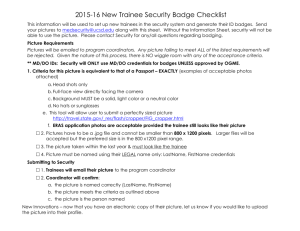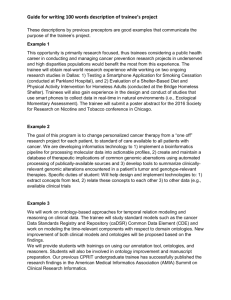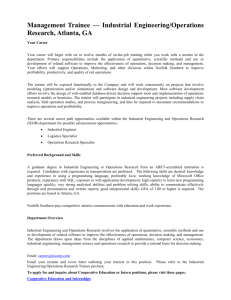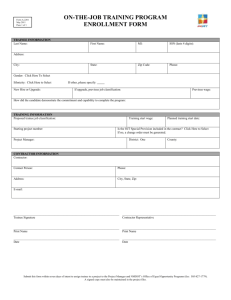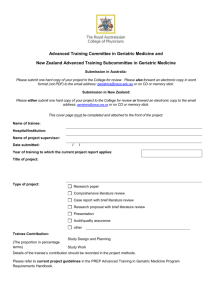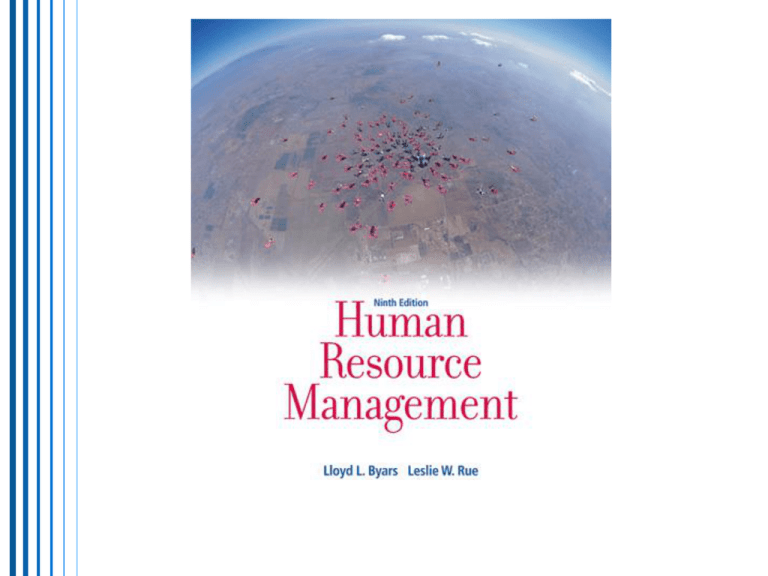
Management
and
Organizational
Development
Chapter 9
McGraw-Hill/Irwin
Copyright © 2008 by The McGraw-Hill Companies, Inc. All Rights Reserved.
Chapter Overview
•
The Management Development Process
•
Determining the Net Management Requirements
•
Needs Assessment
•
Establishing Management Development Objectives
•
Methods Used in Management Development
•
Evaluation of Management Development Activities
•
Assessment Centers
•
Organizational Development
•
Summary of Learning Objectives
9-3
The Management Development Process
• Is concerned with developing the experience,
attitudes, and skills necessary to become or
remain an effective manager
• It must have the full support of the
organization’s top executives
• Management development should be designed,
conducted, and evaluated on the basis of
• Objectives of the organization
• Needs of individual managers who are to be
developed
• Anticipated changes in organization’s
management team
9-4
The Management Development Process
9-5
Determining The Net Management
Requirements
• Organization’s objectives - Play a
significant role in determining the
organization’s requirements for
managers.
9-6
Management Inventory and Succession
Plan
•
Management inventory – Specialized, expanded form of
skills inventory for an organization’s current
management team
• Includes basic types of information, and brief
assessment of past performance and potential for
advancement
• Can be used to fill vacancies that occur
unexpectedly
• Can be used in planning development needs of
individual managers
• These plans can be used to pinpoint
development activities for the total organization
• Can be used to develop a management
succession plan, sometimes called a
replacement chart or schedule
9-7
Management Inventory and Succession
Plan
• Management succession plan – Chart or
schedule showing potential successors for each
management position within the organization
• It may simply be a list of positions and
potential replacements
• Both are generally kept confidential and can be
computerized
• Maintained by human resource department for
use of top executives
9-8
Sample of a Simplified Management
Inventory
9-9
Replacement Plan for Administrative
Division of a Typical Organization
9-10
Changes in the Management Team
•
Changes in the management team
•
Some can be estimated fairly accurately and easily
• Retirements – Predicted from information in management
inventory
• Transfers and promotions – Estimated from planned
retirements of individuals in specific jobs and objectives
of the organization
•
Some are not so easily determined
• Deaths, resignations, and discharges
•
Management inventory and succession plan can be used to help
fill vacancies when changes occur
•
Human resource department can gain a good picture of quality
and quantity of managers needed by
•
Analyzing organization’s objectives
•
Studying management inventory and succession plan
•
Evaluating changes in the management team
9-11
Needs Assessment
•
Needs relate to what the organization must have to
achieve its objectives
•
A fundamental need of any organization is the need for an
effective management team
• Use of a well-organized management development
program
•
Before management development activities are
undertaken, specific development needs of managers in
the organization must be determined
•
Needs assessment – A systematic analysis of specific
management development activities the organization
requires to achieve its objectives
• Management development needs of any organization
result from overall needs of organization and
development needs of individual managers
9-12
Needs Assessment
•
Four methods exist to determine management
development needs
• Training needs survey
• Focuses on knowledge and skills required in
performing the job
• Competency studies
• Examine the competencies required in performing
the managerial job
• Task analysis
• Concerned with what tasks are required in
performing managerial job
• Performance analysis
• Deals with job performance requirements in
performing managerial job
9-13
Management Development Program
Needs Assessment Questionnaire
9-14
Management Development Program
Needs Assessment Questionnaire
9-15
Comparison of Four Approaches to
Determining Management Development
Needs
9-16
Establishing Management Development
Objectives
• Objectives for the overall management
development program and for individual programs
must be
• Expressed in writing
• Measurable
• Management development objectives can be
categorized as
• Instructional
• Organizational and departmental
• Individual performance and growth
9-17
Establishing Management Development
Objectives
•
•
Instructional objectives – Might incorporate
•
Targets relating to number of trainees to be taught
•
Hours of training
•
Cost per trainee
•
Time required for trainees to reach a standard level of knowledge
•
Objectives needed for principles, facts, and concepts to be learned
Organizational and departmental
•
•
Concern the impact programs will have on organizational and
departmental outcomes, such as absenteeism, turnover, safety, and
number of grievances
Individual performance and growth
•
Concern impact on behavioral and attitudinal outcomes of individual
•
May involve impact on personal growth of individuals participating
•
Individual program objectives specifying skills, concepts, or attitudes that
should result must be identified
•
Course content and method of instruction can be specified after
9-18
Methods Used in Management
Development
• The list of conditions for effective learning apply
to management development programs
• As with employee training, management
development can be achieved both on and off
the job
9-19
Selected Methods Used in Management
Development
9-20
Understudy Assignments
•
On-the-job training in which one individual, designated as the heir
to a job, learns the job from the present job holder
•
•
•
•
Used to develop an individual’s capabilities to fill a specific
job
Advantages
•
Heir realizes purpose of the training
•
Can learn in a practical and realistic situation without being
directly responsible for operating results
Disadvantages
•
Understudy learns the bad as well as the good practices of
incumbent
•
Understudy assignments maintained over a long period can
become expensive
If used, it should generally be supplemented with one or more of
the other management development methods
9-21
Coaching
•
Management development conducted on the job that
involves experienced managers advising and guiding
trainees in solving managerial problems
• Emphasizes responsibility of all managers for
developing employees
•
Advantage
• Trainees get practical experience and see results of
their decisions
•
Disadvantage
• Danger of the coach neglecting training responsibilities
or pass on inappropriate management practices
•
The coach’s expertise and experience are critical with this
method
9-22
Experience
•
Individuals are promoted into management jobs and
allowed to learn on their own from daily experiences
•
Advantage
• Individual, in performing a specific job, may recognize
need for management development and look for a
means of satisfying it
•
Disadvantage
• Employees allowed to learn management only through
experience can create serious problems by making
mistakes
• Frustrating to attempt to manage without necessary
background and knowledge
•
Serious difficulties can be avoided if experience method is
supplemented with other management development
techniques
9-23
Job Rotation
•
Designed to give an individual broad experience through
exposure to many different areas of organization
•
Trainee goes from one job to another within the organization,
generally remaining in each from six months to a year
•
Large organizations frequently use this for training recent college
graduates
•
Advantage
•
•
Trainees can see how management principles can be applied
in a cross section of environments
•
Training is practical and allows the trainee to become familiar
with entire operation of company
Disadvantage
•
Trainee is frequently given menial assignments in each job
•
Tendency to leave trainee in each job longer than necessary
•
Both of these disadvantages can produce negative attitudes
9-24
Special Projects and Committee
Assignments
•
Special projects require trainee to learn about a particular subject
•
For example, a trainee may be told to develop a training
program on safety
• Requires learning about organization’s present safety
policies and problems and safety training procedures
used by other companies
• Trainee must also learn to work and relate to other
employees
•
•
Critical that they provide a developing and learning
experience for trainee and not just busywork
Committee assignments (similar to special projects) – Used if
organization has regularly constituted or ad hoc committees
•
Individual works with committee on its regularly assigned
duties and responsibilities
•
Person develops skills in working with others and learns
through the activities of the committee
9-25
Classroom Training
• Most familiar type of training; can utilize several
methods
• Used in
• Management development programs
• Orientating and training activities
• Include
• Lectures
• Case studies
• Role playing
9-26
Lectures
•
Common method of instruction (teaching by spoken word)
•
•
Can include other media such as transparencies, slides, videotapes,
or computer slides such as PowerPoint
Strengths include
•
Communicates intrinsic interest of subject matter
• Lecturer can communicate their enthusiasm for subject, which
should enhance the audience’s interest in learning
•
Lectures can cover material not otherwise available
•
Lecturers can reach many learners at one time
•
Lecturers can serve as effective models for their audience
• Effective lecturers convey information and convey what does
and does not work in different settings
•
Lecture method lets instructor control what will be covered, the
sequence in which it will be covered, and how much time will be
devoted to each topic
•
Lectures pose a minimal threat to the learner
9-27
Lectures
•
Weaknesses include
• Lectures often do not allow for feedback from the
audience
• Listeners are often passive
• Length of lecture periods often does not match
listener’s interest spans
• Lecturing fails to allow for individual differences in
ability or experience
• Lectures are unsuitable for certain higher forms of
learning, such as analysis and diagnosis
• Lectures are partially dependent on the public speaking
skills and abilities of the lecturer
9-28
Case Studies
•
Classroom training in which trainee analyzes real or hypothetical
situations and suggests not only what to do but also how to do it
•
Case study should force trainee to
• Think through problems
• Propose solutions
• Choose among them
• Analyze consequences of decision
•
Success of this method depends heavily on skills of the instructor
•
•
Asking probing questions and keeping everyone involved in
analysis of case are critical for its success
Incident method – Form of case study in which learners are
initially given general outline of a situation and receive additional
information from the instructor only as they request it
•
Makes students probe situations and seek additional
information, much as they would be required to do in real life
9-29
Case Studies
•
•
Advantages of case method include
•
Emphasize analysis of a situation that is typical of manager’s
world
•
Improves learner’s verbal and written communications skills
•
Expose learners to a wide range of true-to-life management
problems
•
Inspire interest in otherwise theoretical and abstract training
material
Possible weaknesses of case method include
•
Often focus on past and static considerations
•
Case analysis often lacks emotional involvement on the part
of the student
• Thus is unrealistic in terms of what trainee would actually
do in the situation
•
Case analysis can sometimes confuse students who are
used to definite solutions
9-30
Role Playing
• Participants are assigned different roles and
required to act out those roles in a realistic
situation
• Idea is for participants to learn from playing
out the assigned roles
• Its success depends on ability of participants to
assume the roles realistically
• Videotaping allows for review and evaluation of
the exercise to improve its effectiveness
9-31
In-Basket Technique
•
Participant is required to simulate the handling of a specific
manager’s mail and telephone calls and to react
accordingly
•
Important duties are interspersed with routine matters
• For instance, one call may come from an important
customer who is angry, while a letter from a local civic
club may request a donation
•
Participants analyze situations and suggest alternative
actions
• Evaluated on basis of number and quality of decisions
• Evaluated on priorities assigned to each situation
•
It has been used
• For management development
• In assessment centers
9-32
Web-Based Training (WBT)
• Material is presented on computer video screens
via either the Internet or company intranet;
participants are required to answer questions
correctly before being allowed to proceed
• Participants can take courses either
independently or in real time with an
instructor, through a network connection
• Online courses are most often given in
conjunction with instructor-led courses –
Employees have advantage of seeing hands-on
demonstrations
• Allows work-life balance for employees due to
flexibility of time, place and programs
9-33
Web-Based Training (WBT)
• Method takes advantage of technology
available in virtual classroom
• Virtual classrooms can be
• Asynchronous classroom - Allow students and
instructors to engage in learning activities without
being online at same time
• Synchronous classrooms – Allow students and
instructors to be online simultaneously
• It is likely that WBT will continue to grow
both in large and small organizations
9-34
Business Simulations
•
Simulates an organization and its environment and requires a team of
players to make operating decisions based on situation
•
Instructor can add in
• Complexity
• Economic events
• Human resource challenges
•
Forces individuals to work
•
With other group members
•
Function in an atmosphere of competition within industry
•
Advantages include
•
•
They simulate reality
•
Decisions are made in a competitive environment
•
Feedback is provided concerning decisions
•
Decisions are made using less than complete data
Disadvantage
•
Many participants simply attempt to determine key to winning
9-35
Adventure Learning
(Experiential-Learning Programs)
•
Programs that use many kinds of challenging outdoor
activities (often involving physical risk) to help participants
achieve their goals
•
Group-focused objectives – Include
• Better communication
• More creative problem solving
• More effective teamwork
• Improved leadership
• “The Wall,” – A 12- to 14-foot structure that teams must
get over by working together
• Viewed as a symbol for any business challenge
9-36
Adventure Learning
(Experiential-Learning Programs)
•
Personal growth objectives – Include
• Improved self-esteem
• Improved risk-taking skills
• Increased self-awareness
• Better stress management
• Rope activities are favorite methods for achieving
personal growth objectives
• “Electric rope” game – Team has to get every
member over a rope strung high up between two
trees
• Team members must try not to touch the rope, and
cannot use props
• Viewed as an analogy for a difficult business
challenge team faces at work
9-37
University and Professional Association
Seminars
• Colleges and universities offer both credit and
noncredit courses intended to help meet
management development needs of various
organizations
• Offerings range from courses in principles of
supervision to advanced executive management
programs
• Professional associations such as American
Management Association offer a wide variety of
management development programs
• Programs use many of the previously
discussed classroom techniques
9-38
Evaluation Of Management
Development Activities
•
Four alternatives exist for evaluating management
development activities
•
Each focuses on the following questions:
• Alternative I – Are trainees happy with the course?
• Alternative II – Does training course teach the
concepts?
• Alternative III – Are the concepts used on the job?
• Alternative IV – Does application of the concepts
positively affect the organization?
•
For each of the four alternatives
• Organization must determine what might be measured
to answer questions posed by the alternative
9-39
Evaluation Matrix
9-40
Assessment Centers
•
Formal method used in training and/or selection and aimed
at evaluating an individual’s potential as a manager by
exposing individual to simulated problems that would be
faced in a real-life managerial situation
• Trained observers evaluate various personality traits of
assessees based on their performance in specially
chosen exercises
•
Critical to any assessment center is the development of list
of personality characteristics to be assessed
• They should be directly related to successful
performance of particular jobs for which assessees are
being evaluated
• Only when they have been identified can exercises be
selected for use in the assessment center
•
Research indicates that certain exercises are more
relevant for measuring some personality traits than others
9-41
Assessment Centers
•
•
•
Exercises used in assessment centers include
•
In-basket exercises
•
Business simulations
•
Group discussions
•
Cases
•
Interviews
•
Various paper-and-pencil tests
Involve the assessees in situations that require
•
Decision making
•
Leadership
•
Written and oral communication
•
Planning
•
Organizing
Assessors
•
Observe assessees while they are involved in various exercises
•
Evaluate performance based on personality characteristics being
assessed
9-42
Assessment Centers
•
Assessees generally examined in groups of
approximately six persons
• Their to be assessed personality characteristics
are similar
• They occupy similar positions in the organization
•
Selection of assessment staff (assessors)
• Trained professionals such as industrial
psychologists are frequently used
• Successful managers used in the belief that they
would best know the qualities required for success
• Several assessors are used in the evaluation
process
9-43
Assessment Centers
•
Assessors observe assessees
• In their performance of various exercises
• Individually, and evaluate them
•
Assessors gather together and review each
assessee in depth on each personality characteristic
to be assessed
• Each is ranked on a relative scale such as “more
than acceptable,” “acceptable,” or “not
acceptable”
•
Use of assessment centers
• Predictor of success in some position for which
assessee is being considered
• Identify special training that the assessee may
require
9-44
Organizational Development
•
Organizationwide, planned effort managed from the top,
with the goal of increasing organizational performance
through planned interventions and training experiences
• Looks at human side of organizations
• Seeks to change attitudes, values, organizational
structures, and managerial practices to improve
organizational performance
•
Ultimate goal is to structure organizational environment so
that
• Managers and employees can use developed skills
and abilities to fullest
•
Initial phase is a recognition by management that
organizational performance can and should be improved
9-45
Phases of Organizational Development
•
Diagnosis – Involves gathering and analyzing information about
organization to determine areas in need of improvement
•
•
Change planning – Involves developing a plan for organizational
improvement based on data obtained
•
•
•
Information gathered through use of questionnaires or attitude
surveys
Identifies specific problem areas in organization and outlines steps
to resolve them
Intervention/education – Involves sharing diagnostic information with
people affected by it and helping them realize need for change
•
Involves use of outside consultants working with individuals or
employee groups
•
Involves use of management development programs
Evaluation phase – In effect repeats diagnostic phase
•
Data are gathered to determine effects of OD effort on total
organization
•
Information can lead to more planning and education
9-46
Diagnosis
•
The primary decision to be made is whether organization
has talent and available time necessary to conduct
diagnosis
• If not, an alternative is to hire an outside consultant
•
After deciding who will do the diagnosis, information is
gathered and analyzed
•
In this stage, data should be collected for a reason
• Plan for analyzing data to be developed even before
data collection
•
Some of the most frequently used methods involve using
• Available records
• Survey questionnaires
• Personal interviews
• Direct observation
9-47
Diagnosis
•
•
Available records – Review any available records or documents
that may be pertinent
•
Personnel records
•
Financial reports
Survey questionnaires – Most popular method of gathering data
•
•
Personal interviews – Employees are individually interviewed
about opinions and perceptions and certain work-related factors
•
•
Usually intended to measure employee attitudes and
perceptions about certain work-related factors
Takes more time than survey questionnaire method but can
result in better information
Direct observation – Person conducting diagnosis observes
firsthand the behavior of organizational members at work
•
Advantage – Allows observation of what people actually do
as opposed to what they say they do
9-48
Strategy Planning
•
Data collected in diagnosis stage must be carefully
interpreted to determine the best plan for organizational
improvement
•
If similar diagnosis has been done before, data
comparison can reveal obvious differences, if any
•
Areas of disagreement will exist since much of the
collected data are based on personal opinions and
perceptions
•
The key to interpreting data is to look for trends and areas
of general agreement
•
End result of this process is to identify specific problem
areas and outline steps for resolving the problems
9-49
Education
• Purpose is to share information obtained in the
diagnostic phase with affected employees
• Helps them realize need for change
• Thorough analysis in change-planning phase
results in identifying most appropriate
intervention/education method to use
• Frequently used intervention/education methods
include
• Direct feedback
• Team building
• Sensitivity training
9-50
Education
•
Direct feedback – Change agent communicates
information gathered through diagnosis directly to affected
people
• Change agent explains what was found and changes
recommended
• Workshops often conducted to initiate desired changes
•
Team building - A work group develops awareness of
conditions that keep it from functioning effectively and
takes action to eliminate these conditions
• Some specific activities used include
• Clarifying employee roles
• Reducing conflict
• Improving interpersonal relations
• Improving problem-solving skills
9-51
Education
• Sensitivity training – Method used to make one
more aware of oneself and one’s impact on
others
• Training group or T-group meeting with no
agenda or particular focus
• Normally has between 10 and 15 people –
May or may not know one another
• Agenda – Behavior of individuals in trying to
deal with lack of structure, due to absence of
planned structure, and common prior
experience
• Members are encouraged to learn about
themselves and others in nonstructured
environment while engaging in group dialogue
9-52
Education
• Has been both criticized and defended as
to its relative value for organizations
• Research shows people having undergone
sensitivity training tend to show
• Increased sensitivity
• More open communication
• Increased flexibility
• These same studies indicate that while
outcomes of sensitivity training are
beneficial in general, it is difficult to predict
outcomes for any one person
9-53
Evaluation
•
Probably the most difficult phase in the OD process
•
Basic question to be answered is – Did the OD process
produce the desired results?
•
OD efforts begin with admirable but overly vague
objectives such as improving the overall
• Health
• Culture
• Climate
•
Before any OD effort can be evaluated, explicit objectives
must be determined
•
Objectives of an OD effort should
• Be outcome oriented
• Lend themselves to development of measurable criteria
9-54
Evaluation
•
Evaluation effort should be methodologically sound
•
OD effort should be evaluated using hard, objective data. Two
approaches include
•
Comparing data collected before OD intervention against data
collected after OD intervention
•
Comparing “before” and “after” data with similar data from a
control group
• Involves identifying an experimental group and a control
group
• OD effort is implemented with experimental group but not
with control group
• After completion, before and after data from experimental
group are compared with before and after data from control
group
• Helps rule out changes that may result from factors other
than OD intervention
•
Practically, may be desirable to use different personnel to evaluate
an OD effort than those who implemented effort
9-55
Summary of Learning Objectives
• Define management development
• Describe a management inventory
• Describe a management succession plan
• Define the in-basket technique
• Describe a business simulation
• Describe adventure learning
• Define an assessment center
• Describe organizational development (OD)
• Outline the four phases in organizational
development
9-56


